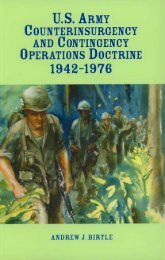C. Wiebes - Intelligence en de oorlog in Bosnië 1992-1995. De rol van de inlichtingen- en veiligheidsdiensten - Engels
C. Wiebes - Intelligence en de oorlog in Bosnië 1992-1995. De rol van de inlichtingen- en veiligheidsdiensten - Engels
C. Wiebes - Intelligence en de oorlog in Bosnië 1992-1995. De rol van de inlichtingen- en veiligheidsdiensten - Engels
- No tags were found...
You also want an ePaper? Increase the reach of your titles
YUMPU automatically turns print PDFs into web optimized ePapers that Google loves.
94cutbacks recomm<strong>en</strong><strong>de</strong>d by the Van Ids<strong>in</strong>ga Commission, a str<strong>en</strong>gth<strong>en</strong><strong>in</strong>g of the MIS/CO analysiscapacity from 28 to 42 staff was <strong>de</strong>emed necessary, whereas the same commission recomm<strong>en</strong><strong>de</strong>d thatthe number of Army <strong>in</strong>tellig<strong>en</strong>ce positions could be reduced from 47 to 41. For the <strong>in</strong>tellig<strong>en</strong>cedoma<strong>in</strong>, the <strong>de</strong>sirability of a <strong>de</strong>c<strong>en</strong>tralized approach was confirmed, however: <strong>in</strong> other words <strong>in</strong> theArmed Forces as opposed to the C<strong>en</strong>tral Organization. 431In the 1990s, crisis managem<strong>en</strong>t and peace operations also ma<strong>de</strong> their mark on thecounter<strong>in</strong>tellig<strong>en</strong>ce and security doma<strong>in</strong>. This ma<strong>in</strong>ly <strong>in</strong>volved promot<strong>in</strong>g the security of Dutchsoldiers. The <strong>de</strong>brief<strong>in</strong>g of military personnel that had participated <strong>in</strong> peace operations was becom<strong>in</strong>g<strong>in</strong>creas<strong>in</strong>gly important with a view to security aspects. All <strong>in</strong> all, the crisis managem<strong>en</strong>t operations led tonew <strong>in</strong>tellig<strong>en</strong>ce requirem<strong>en</strong>ts, which would seriously aggravate the pressure of work on the MIS,especially after the summer of <strong>1995.</strong> 432The MIS/CO’s sourcesThe <strong>Intellig<strong>en</strong>ce</strong> Staff of the MIS/CO was to make use of Op<strong>en</strong> Source <strong>Intellig<strong>en</strong>ce</strong> (Os<strong>in</strong>t), Human<strong>Intellig<strong>en</strong>ce</strong> (Hum<strong>in</strong>t) and Signals <strong>Intellig<strong>en</strong>ce</strong> (Sig<strong>in</strong>t) for its <strong>in</strong>tellig<strong>en</strong>ce production. The MIS has<strong>in</strong>vested <strong>in</strong> the <strong>de</strong>velopm<strong>en</strong>t of op<strong>en</strong> sources, especially <strong>in</strong> rec<strong>en</strong>t years. This has meant more use ofcommercial data banks and Internet. It goes without say<strong>in</strong>g that the service also had many national and<strong>in</strong>ternational professional journals, weekly magaz<strong>in</strong>es and daily newspapers at its disposal. The MIS alsoexhibited the <strong>in</strong>ternational t<strong>en</strong>d<strong>en</strong>cy of mak<strong>in</strong>g exhaustive use of op<strong>en</strong> sources prior to resort<strong>in</strong>g tomore clan<strong>de</strong>st<strong>in</strong>e sources of <strong>in</strong>formation, such as human sources and Sig<strong>in</strong>t. Another source of<strong>in</strong>tellig<strong>en</strong>ce was the reports of the military attachés <strong>in</strong> other countries. 433With respect to <strong>in</strong>formation from human sources, there was an Operations <strong>De</strong>partm<strong>en</strong>t with<strong>in</strong>the MIS/CO that was responsible for recruit<strong>in</strong>g and runn<strong>in</strong>g <strong>in</strong>formants and ag<strong>en</strong>ts. This <strong>de</strong>partm<strong>en</strong>twas ma<strong>in</strong>ly created from the collaboration of the Counter<strong>in</strong>tellig<strong>en</strong>ce (CI) <strong>de</strong>partm<strong>en</strong>ts of the ‘old’military <strong>in</strong>tellig<strong>en</strong>ce services of the Royal Netherlands Army and the Royal Netherlands Air Force. This<strong>de</strong>partm<strong>en</strong>t orig<strong>in</strong>ally restricted itself to counter<strong>in</strong>tellig<strong>en</strong>ce operations, but after the Foreign<strong>Intellig<strong>en</strong>ce</strong> Service (IDB) was disban<strong>de</strong>d on 1 January 1994, Operations started to make its owncontribution to ‘fill<strong>in</strong>g the hole’ left by the IDB. A start was th<strong>en</strong> ma<strong>de</strong> on build<strong>in</strong>g up Hum<strong>in</strong>tresources and closer collaboration with the BVD. 434 S<strong>in</strong>ce mid 1996, this Operations <strong>De</strong>partm<strong>en</strong>t hasma<strong>de</strong> an actual start on operations <strong>in</strong> the <strong>in</strong>tellig<strong>en</strong>ce and counter<strong>in</strong>tellig<strong>en</strong>ce area. The writt<strong>en</strong> accountsof the operational work can be found <strong>in</strong> what are known as the ‘O Files’ that conta<strong>in</strong> data on thesource, the operation files with <strong>in</strong>formation on the <strong>de</strong>velopm<strong>en</strong>t of the operation, and f<strong>in</strong>ally the<strong>in</strong>formation files conta<strong>in</strong><strong>in</strong>g the <strong>in</strong>tellig<strong>en</strong>ce provi<strong>de</strong>d by the source. The <strong>in</strong>formation reports were s<strong>en</strong>tto users, such as the <strong>Intellig<strong>en</strong>ce</strong> <strong>De</strong>partm<strong>en</strong>t, also at the MIS/CO. 435The MIS/CO also <strong>en</strong>gaged <strong>in</strong> procur<strong>in</strong>g Sig<strong>in</strong>t. In 1995 there were three military units <strong>in</strong>volved<strong>in</strong> this, one for each branch of the Armed Forces: the First Air Force Signals Group, the 898 th RoyalNetherlands Army Signals Battalion, and the Royal Netherlands Navy Technical InformationProcess<strong>in</strong>g C<strong>en</strong>tre (TIVC). Until 1996, these three operated separately from each other, but <strong>in</strong> that yearthey were <strong>in</strong>tegrated to create one Sig<strong>in</strong>t <strong>De</strong>partm<strong>en</strong>t, which comprised two sections: the OperationalSig<strong>in</strong>t C<strong>en</strong>tre (OVIC) located at Eiberg<strong>en</strong> (<strong>in</strong> the Dutch prov<strong>in</strong>ce of Gel<strong>de</strong>rland) and the StrategicSig<strong>in</strong>t C<strong>en</strong>tre (SVIC) <strong>in</strong> The Hague.The Royal Netherlands Army’s 898 th Signals Battalion <strong>in</strong> Eiberg<strong>en</strong> was <strong>en</strong>gaged primarily <strong>in</strong><strong>in</strong>tercept<strong>in</strong>g military tactical message traffic (<strong>in</strong> the HF band). The Royal Netherlands Navy’s TIVC431 MoD , Archive MI S /CO , Report Van Ids<strong>in</strong>ga, DIS/95/21.11/809 , 29/ 0 3/95 .432 MoD, Archive MI S/CO , Organization and Information Directorate, New balance. MI S Audit Report. Phase 2, pp. 1 and 78, 04/11/98. See also: MoD , Archive CSKL 1994,DOKL/IV, Staff 1 Lk to Crisis staff, No. G2/5818, 11/07/94.433 Engel<strong>en</strong>, <strong>De</strong> Militaire Inlicht<strong>in</strong>g<strong>en</strong>d i<strong>en</strong>st , p. 145.434 Interview with HMID, P.J. Duijn, 04/04/01.435 Engel<strong>en</strong>, <strong>De</strong> Militaire Inlicht<strong>in</strong>g<strong>en</strong>di<strong>en</strong>st, pp. 143-144.





